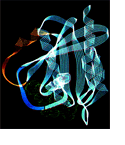Return to Online
Education Kit
|
 |
 |
 Previous Event | Next Event Previous Event | Next Event 
2000: Yeast Interactome Published

Protein-protein interactions play essential roles in determining cellular structures and defining the cell’s biochemistry. An important tool for studying protein-protein interactions is the yeast two-hybrid system. In this system when two proteins interact with each other, they activate the expression of a reporter gene that produces a colored product within the yeast cell. In the yeast interactome study, the two-hybrid system was scaled up allowing researchers to catalog all protein-protein interactions within the yeast cell. It is thought that a similar approach will allow researchers to catalog all interactions between human proteins, generating a map of the human interactome. A map of such protein interactions will help scientists better understand the chemistry of the cell and help identify new targets for drug development.
More Information
The yeast two-hybrid system was developed to allow researchers to detect proteins that physically interact with each other in the cell. The technique relies on manipulating proteins called transcription factors. These proteins get their name because they bind to genes and turn on transcription. The first protein to be used for this purpose was a yeast protein called GAL4. This protein consists of two parts called domains; one is used to bind to the DNA and the second is used to activate transcription of the gene. Both domains must be present in order for the transcription factor to turn on gene expression.
The idea behind the yeast two-hybrid system is to separate the two domains of the transcription factor, attach each domain to different proteins being studied, and give them an opportunity to interact within the cell. The interaction is detected by activating the transcription of a reporter gene. A reporter gene is one whose expression is easily visualized, for example by producing a colored product. In using the yeast two-hybrid system, two different hybrids are constructed:
- The DNA binding hybrid – This hybrid contains the DNA binding domain attached to a protein under study (sometimes called the “bait”). The DNA binding hybrid is a fusion protein that can bind to the reporter gene but cannot activate transcription.
- The transcription activation hybrid – This hybrid consists of the activation domain attached to another protein under study (sometimes called the “prey”). The transcription activation hybrid is a fusion protein that cannot activate expression of the reporter gene because it lacks the ability to bind to the DNA.
Typically when using the yeast two-hybrid system, one bait protein is used and it is tested against a library of many different prey proteins. When the bait protein interacts with a prey protein, the resulting complex can both bind to the reporter gene and activate its expression. Expression of the reporter gene indicates that the bait and prey proteins interact within the cell.
Reference:
Ito, T., Tashiro, K., Muta,S., Ozawa, R., Chiba, T., Nishizawa, M., Yamamoto, K., Kuhara, S., Sakaki, Y. Toward a protein-protein interaction map of the budding yeast: a comprehensive system to examine two-hybrid interactions in all possible combinations between the yeast proteins. Proc Natl Acad Sci USA, 97(3):1143-1147. 2000. [PubMed]
 Previous Event | Next Event Previous Event | Next Event 
Last Updated: April 7, 2008
|

